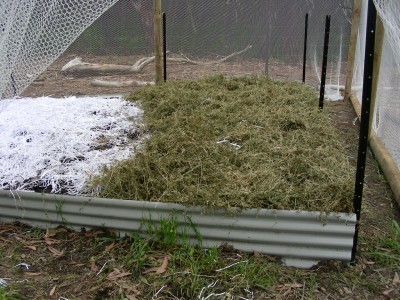






Using hay in compost piles has two distinct advantages. First, it gives you plenty of brown materials in the middle of the summer growing season, when most of the freely available ingredients are green. Also, composting with hay bales allows you to construct a completely green compost bin that eventually turns into compost itself. You can find hay for compost on farms that offer spoiled hay at the end of the year, or in garden centers offering autumn decorations. Let’s learn more about composting hay.
Learning how to compost hay is a simple matter of building a square with old hay bales. Lay out a number of bales to create a square outline, then add a second layer of bales to build up the walls on the back and sides. Fill the middle of the square with all the materials to compost. The shorter front allows you to reach into the square to shovel and turn the heap weekly and the higher walls help keep in the heat to make the materials rot faster.
Once the compost is complete, you’ll notice that part of the walls have begun to incorporate themselves into the composting process. Add the composting hay to the other materials by clipping the twine that holds the bales in place. Add the twine to the compost heap or save it to use as organic ties for supporting tomato plants. The additional hay will mix in with the original compost, increasing the size of your compost supply.
You should note that some growers use herbicide in their hay fields to keep weeds down. If you are planning to use the compost for landscaping, this won’t be a problem, but these herbicides affect some food crops badly.
Test your finished compost by grabbing a trowel full in 20 different spots in the heap, both deep inside and near the surface. Mix them all together, then mix this with potting soil in a 2-to-1 ratio. Fill one planter with this mixture and another with pure potting soil. Plant three bean seeds in each pot. Grow the beans until they have two or three true leaves. If the plants look identical, the compost is safe for food crops. If the plants in the compost are stunted or otherwise affected, use this compost for landscaping purposes only.
How to Build a Composting Toilet
Winter Composting: How To Keep Compost Over Winter
Kitchen Composting: How To Compost Food Scraps From The Kitchen
Can You Compost Diapers: Learn About Composting Diapers At Home
Composting Fish Waste: Tips On How To Compost Fish Scraps
Learn How To Compost- The Easy Way.
Composting How To: Tips On Starting A Compost Pile At Home
Making Compost Indoors – How To Compost In The Home
Composting Leaves In Garden: Learn The Benefits Of Leaf Compost
Kitchen Composting: How To Compost Food Scraps From The Kitchen
Can You Compost Diapers: Learn About Composting Diapers At Home
Composting Leaves In Garden: Learn The Benefits Of Leaf Compost
Copyright © www.100flowers.win Botanic Garden All Rights Reserved